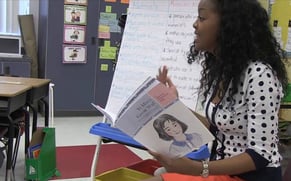Each Thursday on the EiE blog, we answer your questions about classroom engineering.
Q: I know that each Engineering is Elementary Teacher Guide comes with one copy of the storybook for the unit. Do I need to buy additional copies for my students to read?
A: The answer is, it depends on the ages and abilities of your students.
 EiE storybooks are written at about a 5th-grade reading level; they're classified this way because of all the science and engineering vocabulary words in the stories!
EiE storybooks are written at about a 5th-grade reading level; they're classified this way because of all the science and engineering vocabulary words in the stories!
If you teach upper elementary students (or students with advanced reading skills), a class set of storybooks allows each student to read independently. Or you might have your students read in pairs, or small groups.
Many EiE teachers choose to read the story aloud. But you still might want a class set of storybooks, so that each student can follow along.
Picture This: Show Illustrations On-Screen
 If you’re reading a storybook aloud, you can show pictures old-school, by simply holding up the book. Or if you have the technology, you can show them to the class using a projector. Download the storybook illustrations from the "Resources" section of the EiE website.
If you’re reading a storybook aloud, you can show pictures old-school, by simply holding up the book. Or if you have the technology, you can show them to the class using a projector. Download the storybook illustrations from the "Resources" section of the EiE website.
Many EiE teachers who work with younger students divide the storybook in sections, instead of reading the entire story in one class period. Teachers tell us that they may also condense and summarize the stories for the youngest students.
Turn EiE Storybooks into Talking Books!
 Besides reading aloud, here’s another way students can HEAR the story: turn the EiE storybooks into “talking books.”
Besides reading aloud, here’s another way students can HEAR the story: turn the EiE storybooks into “talking books.”
Fifth graders at Brentwood Magnet Elementary School of Engineering did this for ten of the EiE storybooks. Kids read the stories aloud—and engineered the recording sessions!
Teachers at Brentwood say the initiative boosted literacy skills both for the kids doing the reading and recording AND the kids doing the listening. Check out these charming talking books on the Brentwood website. Maybe your students would like to create their own audiobooks!
A Storyteller Makes Stories Accessible to All Students
Another creative strategy comes from the educators at Mesa Public Schools in Arizona. They brought in a professional storyteller to tell three EiE stories in three ways—one at a level suitable for kindergarteners, one for intermediate grades, and one for upper elementary students. They videotaped her performances, so they could be shared in lots of classrooms.
For each of the 20 EiE units, your Teacher’s Guide includes a variety of resources for integrating engineering with English Language Arts, including tips for reading the storybook with English Language Learners, a vocabulary list, sets of pre- and post-reading questions, and thoughtful discussion prompts.
No matter how you share the EiE storybooks, they’ll help your students build reading and language skills . . . while they engineer.
Do you have a tip for teaching EiE? We'd love to hear from you.
Engineering is Elementary is a project of the National Center for Technological Literacy® at the Museum of Science, Boston.









